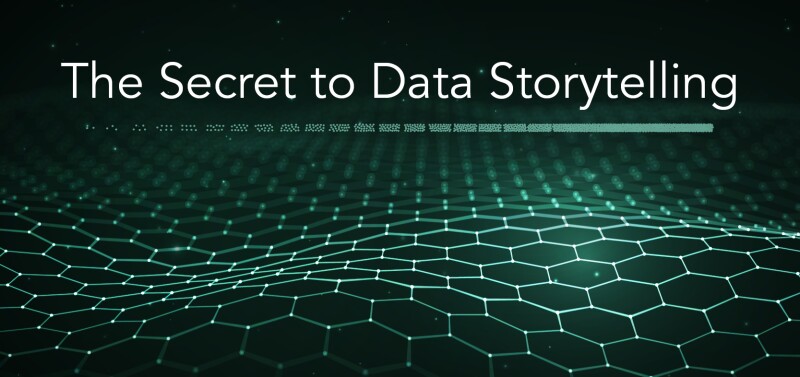We live in an era of boundless data. Availability is no longer a concern—the nearly unlimited information gathered about users online is a marketer's dream. Powerful software tools enable mathematically minded experts to comb through this information and analyze trends, and organizations in numerous industries are increasingly relying on big data.
But all the data in the world means nothing if it remains a series of inanimate numbers and facts. What do you do when you're drowning in more information than the human brain can process? The answer can be found in a profoundly human tendency: telling stories.
Once a hot new trend, data storytelling has become an essential tool that enables organizations—especially those in finance, education, healthcare and agriculture—to communicate clearly, and individuals who can tell stories with data are increasingly in demand.1
While data by itself has the potential to make a difference for an organization, achieving that potential requires marketers and communicators with both the analytical mind to make sense of data and the creativity to construct a narrative with it.2 If your strengths lie at that intersection, consider how learning data storytelling could help your organization and your career.
Why Does Data Storytelling Matter?
Telling stories with data is key to reaching an audience, whether your end goal is to influence consumers or to guide an organization to make better decisions. Humans throughout history have relied on storytelling to pass along vital information, and storytelling with data plays into this predisposition, allowing analysts to share data in a way that appeals to our capacity for emotional decision-making.
Data analytics and data storytelling have transformed financial markets, marketing agencies, e-commerce sites and healthcare companies. Organizations in these and other fields recognize the value of storytellers who can transform data into something compelling; many organizations are looking to hire specialists or to grow the storytelling knowledge of their existing employees.1
How to Tell a Story With Data
Data storytelling is also known as data visualization, although it involves more than distinctive charts and visually appealing graphics. At its heart, data storytelling is about leveraging data to produce meaningful and actionable insights, sometimes to persuade an audience and compel them toward some specific action or decision.
To succeed in this endeavor, analysts must understand their audience as well as their data—identifying their level of expertise and interest—and they must be able to form a narrative that is compelling, creative, objective and transparent, all in equal measure.
Of course, analysts who commit to data storytelling must also have full command of storytelling basics, which includes the ability to either lead a captive audience or invite higher level engagement. Author-driven storytelling means guiding your reader through the experience with limited opportunities for interaction, much like traditional journalism. Reader-driven storytelling gives your audience tools to explore the data at their own pace, digging deeper where they are most interested.3
Data Storytelling Best Practices
The best data storytelling examples combine both approaches described above, guiding the reader through key sections of the data but allowing more open-ended exploration when appropriate. Other crucial strategies for the data storyteller include:
- Address something your audience wants to know more about, in terms that make sense to them
- Show readers how your data affects them and people like them; make them care
- Look for patterns, relationships and surprising discoveries
- Remember that the best stories are personal and evoke emotion in the listener. Try to focus on one specific element of the story, something with human characters and a compelling, emotionally resonant premise
- Be truthful—let the data guide your story instead of shaping the data to suit the story you want to tell. Readers are perceptive and will see through an attempt to manipulate them with cherry-picked data
- Use good design sense, including legible fonts and intentional color choices4
- Ensure that both the visual and nonvisual components of your data story can stand convincingly on their own5
Choosing the Right Data Storytelling Tools
Any list of data visualization and data storytelling tools must evolve as the field itself evolves, and which tool you should use depends on the specific data you intend to convey. You have many basic visualization options to choose from—charts, infographics and maps, to name a few. Many data storytellers use freely available tools such as Google Fusion Tables to enhance their presentations, and other experts have compiled lists of the best data storytelling tools.6 Regardless of the tool you choose, however, a good sense of narrative and excellent communication skills will serve you well even as the landscape of data visualization continues to change.
Become a Data Storyteller
Data analysis and storytelling are skillsets that have been increasingly in demand for the past two years, with no sign of stopping.7 If you already have a background in analytics, you're perfectly situated to develop the additional skills that will help you fill this need at your current organization. If you’re ready to hone your sense of narrative, tap into your natural creativity and help organizations unlock the stories waiting in data, consider pursuing an Online Master of Science in Business Analytics from William & Mary.
- Retrieved on June 4, 2018, from forbes.com/sites/louiscolumbus/2017/05/13/ibm-predicts-demand-for-data-scientists-will-soar-28-by-2020/#23137cdb7e3b
- Retrieved on June 4, 2018, from forbes.com/sites/brentdykes/2016/03/31/data-storytelling-the-essential-data-science-skill-everyone-needs/#7d1bee6c52ad
- Retrieved on June 4, 2018, from stanford.edu/files/2010-Narrative-InfoVis.pdf
- Retrieved on June 4, 2018, from hackernoon.com/what-data-visualisation-has-taught-me-so-far-daf750dcfbab
- Retrieved on June 4, 2018, from thinkwithgoogle.com/marketing-resources/data-measurement/tell-meaningful-stories-with-data/
- Retrieved on June 4, 2018, from medium.com/@ToTheVictor/nicar30tools-da83db0f3dc6
- Retrieved on June 4, 2018, from blog.linkedin.com/2016/01/12/the-25-skills-that-can-get-you-hired-in-2016

